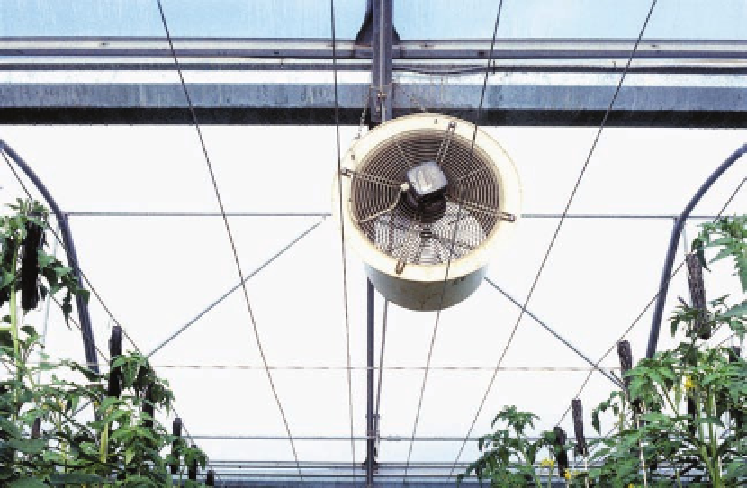Agriculture Reference
In-Depth Information
The air movement through the vegeta-
tion triggers 'thigmomorphogenesis', which
results in thicker stems and shorter inter-
nodes, probably induced by an increase in
the ethylene level in the internodes (Biro
and Jaffe, 1984). This contributes to the
strengthening of the plants (hardening).
9.1.4
Air movement regulation
Air velocities from 0.5 to 0.7 m s
−1
are recom-
mended as optimal for plant growth, to facil-
itate gas exchange (CO
2
and water vapour) at
the leaves (ASHRAE, 1989), whereas veloci-
ties greater than 1 m s
−1
around the leaf
restrict growth (ASAE, 1984).
Some authors recommend that all the
greenhouse air above the canopy should be
moved at velocities of 0.2 m s
−1
, avoiding
stratification of the air layers without gen-
erating turbulence (Hanan, 1998). For this,
fans are commonly installed above the
crop, but never more than 0.9-1.0 m from
the top of the crop, so that some of the air is
also moved inside the canopy (Photo 9.1).
The axis of the fan must be parallel to the
ground surface and in the direction of the
ridge. The required flow is 0.01 m
3
s
−1
per
greenhouse square metre, installing fans in
the direction of air movement at distances
less than 30 times the diameter of the fan
(ASAE, 2002).
When a good air distribution network is
available, such as the one used for carbon
enrichment, air may be circulated inside the
greenhouse
Mechanical stress
The mechanical effect of the wind on the
plants affects their morphology. Any mechan-
ical stimulation, that is intense enough, has
negative effects in any of the growth stages
(Jaffe, 1976). Wind velocities above 4.5 m s
−1
produce mechanical damage (Breuer and
Knies, 1995), but normally these values are
never reached inside a greenhouse.
Temperature and gas exchange
The main effect of air movement on heat
exchange, CO
2
absorption and transpiration
and evaporation is explained by its influ-
ence on the leaf surface boundary layer
(Nobel, 1974a, b).
Air movement decreases the thickness
of the boundary layer, affecting all the pro-
cesses that depend on temperature and gas
exchange.
injecting
air
through
this
network.
Photo 9.1.
Destratification fans are increasingly used to mix the air in the greenhouse.

